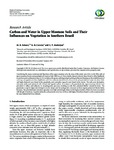Por favor, use este identificador para citar o enlazar este ítem:
http://www.alice.cnptia.embrapa.br/alice/handle/doc/968423Registro completo de metadatos
| Campo DC | Valor | Lengua/Idioma |
|---|---|---|
| dc.contributor.author | SCHEER, M. B. | pt_BR |
| dc.contributor.author | CURCIO, G. R. | pt_BR |
| dc.contributor.author | RODERJAN, C. V. | pt_BR |
| dc.date.accessioned | 2013-10-14T23:31:34Z | - |
| dc.date.available | 2013-10-14T23:31:34Z | - |
| dc.date.created | 2013-10-14 | pt_BR |
| dc.date.issued | 2013 | pt_BR |
| dc.identifier.citation | ISRN Soil Science, v. 2013, p. 1-12, 2013. | pt_BR |
| dc.identifier.uri | http://www.alice.cnptia.embrapa.br/alice/handle/doc/968423 | pt_BR |
| dc.description | Considering the many environmental functions of the upper montane soils, the aims of this study were (1) to verify if the soils of uppermontane forests and grasslands of Caratuva Peak (1850ma.s.l.) have similar characteristics to those found in other highlands in southern and southeastern Brazil; (2) to reinforce the geomorphological and pedological factors that impose the establishment of each type of vegetation in these highlands; and (3) to estimate potential soil carbon stocks and potential soil water retention. Folic and haplic histosols were found in the grasslands, and dystrophic regosols were found in the forests. The soils were dystrophic, extremely acidic, and saturated with Al and total organic carbon. In contrast to the grasslands, the upper montane forests were prevalent in valleys and subjected to morphogenetic processes resulting in soils that contained thicker mineral horizons. The grasslands occupied ridges and divergent convex ramps, and the pedogenetic processes in these regions promoted thicker histic horizons.The potential water retention capacities were high and strongly related to the high porosities of histic horizons associated with the gleyic horizons. In particularly, the carbon stocks were two- to three-fold higher than those found in soil ecosystems from the same latitude but lower altitude. | pt_BR |
| dc.language.iso | eng | eng |
| dc.rights | openAccess | eng |
| dc.subject | Solos altomontana | pt_BR |
| dc.subject | Região Sudeste | pt_BR |
| dc.subject | Brasil | pt_BR |
| dc.subject | Upper montane soils | pt_BR |
| dc.subject | Southern Brazil | pt_BR |
| dc.title | Carbon and water in upper montane soils and their influences on vegetation in Southern Brazil. | pt_BR |
| dc.type | Artigo de periódico | pt_BR |
| dc.date.updated | 2013-10-14T23:31:34Z | pt_BR |
| dc.subject.thesagro | Água | pt_BR |
| dc.subject.thesagro | Carbono | pt_BR |
| dc.subject.thesagro | Vegetação | pt_BR |
| dc.subject.nalthesaurus | carbon | pt_BR |
| dc.subject.nalthesaurus | water | pt_BR |
| dc.subject.nalthesaurus | vegetation | pt_BR |
| dc.description.notes | Article ID 348905. | pt_BR |
| riaa.ainfo.id | 968423 | pt_BR |
| riaa.ainfo.lastupdate | 2013-10-14 | pt_BR |
| dc.identifier.doi | 10.1155/2013/348905 | pt_BR |
| dc.contributor.institution | M. B. Scheer, SANEPAR, PR; GUSTAVO RIBAS CURCIO, CNPF; C. V. Roderjan, UFPR. | pt_BR |
| Aparece en las colecciones: | Artigo em periódico indexado (CNPF)  | |
Ficheros en este ítem:
| Fichero | Descripción | Tamaño | Formato | |
|---|---|---|---|---|
| Curcio.pdf | 5,77 MB | Adobe PDF |  Visualizar/Abrir |









